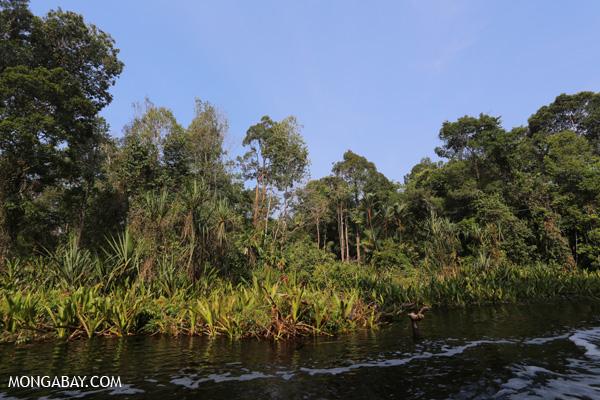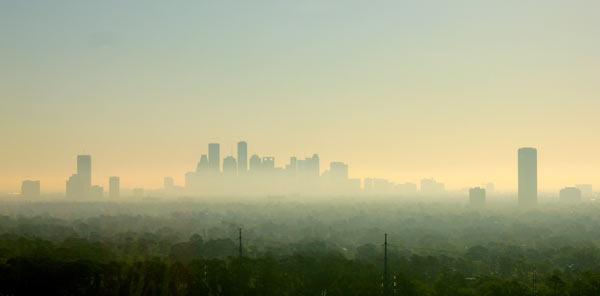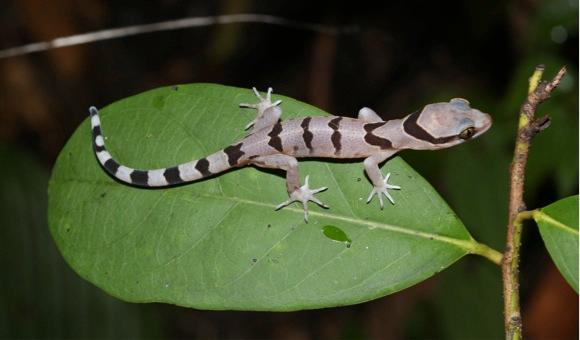The term “artificial” has acquired negative connotations in recent years. However, a recent study in Sumatra’s Harapan rainforest details not only the ecological benefits, but rather thenecessity, of improving artificial wetlands found along waterways in this rainforest ecosystem.
Tropical forest streams across Southeast Asia are in a degraded state, especially where obstructed by logging roads, creating artificial ponds and swamps. The improvement of the quality of those artificial wetlands could help bolster dwindling plant and wildlife populations, and enhance local biodiversity says a new study published in mongabay.com’s open-access Tropical Conservation Science.
The Harapan ecosystem, where the case study was conducted, encompasses 247,100 acres (100,000 hectares) of lowland rainforest. The ecosystem covers four watersheds and about 466 miles (750 kilometers) of river, too. It includes 175 artificial ponds and swamps created by logging road networks over the last 30 to 40 years.
The researchers describe the condition of the artificial ponds and swamps associated with roads in the Harapan rainforest, propose a set of restoration techniques to improve their conservation value, and suggest species suitable for restoration activities.
Although tropical alluvial swamps generally account for less biodiversity than surrounding rainforest, they provide crucial resources to a variety of species, including swamp tree species, amphibians that require flowing streams or standing water for reproduction, and large vertebrates -- including elephants and tapirs -- who commonly visit ponds for drinking water or to cool themselves. Consequently, though rare, alluvial swamps are extremely valuable for surrounding forest biodiversity.
The region’s degraded dammed ponds and artificial wetlands are often flooded and anaerobic, making them resistant to native tree growth. They are also typically surrounded by disturbance responsive species, such as bamboos, ferns and lianas.
The researchers note that restoration should begin by first installing culverts to drain artificial ponds to improve stream flow and create manmade swamps. “Despite the artificial nature of their creation, there is a significant conservation value in improving the alluvial swamps due to the significant decline in extent of this habitat across Southeast Asia,” says the study.
Once drained, the next step is to restore the manmade swamps to a less anthropogenically-manipulated state through the streamside establishment of swamp tolerant woody vegetation, especially late successional species that occur in “model” natural ponds/swamps -- with an emphasis on fruiting species attractive to feeding wildlife.
Two techniques for the removal of overly dominant or invasive species will also be used.Selective thinning is the targeted removal of stems of undesirable species, at the stand level, to increase light penetration to the understory and reduce competition. Release cutting enhances the growth of stems of desirable species by removing competing vegetation from their immediate vicinity.
The researchers propose monitoring and measuring the restoration of artificial swamps, through remote satellite sensing of swamp/pond ecosystems and ground truthing with detailed GPS surveys.
“Restoring dammed streams and their associated swamps should provide an excellent opportunity to increase the extent of… habitat,” write the researchers, providing a promising refuge for alluvial swamp specialist plant and animal species, while offering value to charismatic species such as elephants, tapirs and wetland birds.
“Evidence from Harapan Rainforest has demonstrated that artificial ponds and swamps are slow to recover if left unmanaged.… However, direct management should be relatively low cost,” the study concludes, with culvert installation and wetland re-plantings significantly improving the conservation value of the surrounding rainforest.
Citation:
- Schmidt, L., Prasetyonohadi, D., and Swinfield, T. (2015). Restoration of artificial ponds in logging concessions: a case-study from Harapan Rainforest . Sumatra.Tropical Conservation Science Vol.8 (1): 33-44.
This article was written by Taryn Farber, a contributing writer for news.mongabay.com. This article has been republished with permission, original article here.



